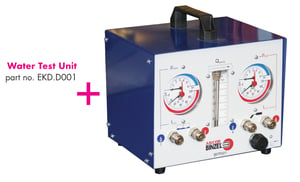When you are going from air-cooled to water-cooled welding torches, the biggest component is water. Since water is a good conductor of electricity, it does pose a threat as far as electrical hazards; whether it's to the welder itself, or to nearby workers, depending on if there is water on the floor. So when you're proposing water-cooled equipment, the maintenance is extremely important. You should be on a regular maintenance schedule. Starting from the water cooler and working our way to the torch, let's go through some steps that should be a part of your regular maintenance schedule.
The water cooler itself should be on it's own maintenance schedule, making sure that you clean it often, depending on usage. Some companies clean their water coolers every six months, and some never do it at all. The companies who never do it all are the ones who have issues with their pumps. A few examples of things to look for, for safety and to keep the pumps from leaking are:
- Lines free of clogs and debris
- Cracks or extreme wear on lines
- "Ballooning" or bubbling of the lines
- Walls of the lines becoming thinner
A bad hose can create a leak, which can be a huge danger to your welding operator. If water spills on the floor while you're welding and touching your work material, you are completing the circuit, so the electricity is then running through you, which creates a huge shock hazard.
Check your water cooler once or twice a year for these symptoms of aging and possible failure. Environment is important not only for maintenance, but welding safety in general. Everybody thinks of your protective equipment when considering safety, but your surroundings play just as big a role in the safe operation of your water-cooled torch components. Generally when talking about a dirty environment, look at whether there's a lot of metal dust, if the floor is clean, or if there's a lot of plasma cutting - which creates a lot of metal scale. A dirty environment can cause ports to clog and machines to malfunction. If welding in a dirtier environment, checking three to four times a year may be necessary.

Helpful tip...
Use BTC-15 or BTC-20 NF (non-flammable) coolant for all MIG applications helps to keep all fittings and connections clean and stops electrolytic action taking place. It also lubricates the pump & will pro-long the life of the torch.

Using the correct coolant mixture is a huge part of using a water-cooled machine. If you are working in a very hot, or very cool environment, you need to make sure that the coolant you are using is rated for that environment. You should not mix water into the coolant because it is pre-mixed. If you mix water into the coolant, you risk having the lines and fittings freeze, crack, or blow because you lessen the viscosity of the pre-mix. This could cause water to flow onto the floor, creating an electrical hazard. Low-conductivity coolant is available to use and is less corrosive to the fittings on your machine.
The only drawback to using this type of coolant is that it does not last as long and will need to be changed more frequently. There are also eco-friendly "green" coolants, which are biodegradable. Do not use antifreeze or coolant meant for cars. It is a different type of mixture and will coagulate, in turn clogging your lines. Distilled water may be used temporarily under emergency situations, but it is not recommended for day to day use. Don't use standard water in such an emergency situation, because of the additives in tap water increase the corrosiveness in it, which will wear your lines and fittings.
Leading up to the torch, you want to make sure the lines are not clogged. You can do this by using the Binzel Flow Switch, whether you use the built-in flow switch on our CR 1000 / 1250 line of water coolers, or use an external switch that you can connect your torch to if you use another type of cooler.
Why use a flow switch? A flow switch will monitor how much volume of coolant is flowing through the lines. Usually the coolant should be flowing through the lines at 45-55 psi. Not enough pressure or too much pressure could cause the hoses to heat up, balloon, and even blow. If these lines become clogged, the Binzel Flow Switch will detect it and notify the welder that there is not enough coolant flowing through the lines and shuts the torch off automatically. If the torch is not shut off and does not have a proper volume of coolant flowing through it, there is a possibility of the torch overheating and the welder becoming injured.
At the torch itself, if you have an overheating problem or a leak, it could create an electrical hazard as well. It is always a good idea to fix or replace any torch suspected of having a leak or overheating, although you can't always tell until it happens. This is why the welder should always take necessary precautions while welding with a water-cooled machine. Wearing latex surgical gloves underneath of your leather welding gloves, as well as wearing the proper, rubber-soled shoes or boots always helps to keep the welders hands and feet dry, especially in humid environments.
A simple check list will often take care of many of the routine water-cooled maintenance issues you will come across every day. Ask yourself these questions:
- Is there any coolant in the water cooler? Coolers should be checked every day by the welder.
- Are the radiator fins blocked up with dust? When was the cooler last blown out with compressed air?
- Are the hose connections the right way round? If not, the fluid will be pumped up the power cable first when it should be pumped to the neck first for maximum cooling of the neck.
- Is the cooled fan working properly? Make sure it's not damaged e.g. fan blades broken etc.
- Is the cooler pump getting too hot? It may be air locked or may be blocked.
- Are you using 'tap water' or 'distilled water' with anti-freeze? Fittings and connections may have become furred up by 'Electrolytic Action' as tap water allows current pass - this will harden and the power cables may become brittle and fail.
If the above steps don't solve the problem then it is recommended you use a piece of equipment called a Water Test Unit to help diagnose the issue.
The Water Test Unit can be used for testing the following:
- Temperature & pressure of cooling liquid in the cooler circuit
- Temperature & pressure of cooling liquid in the torch circuit
- Coolant flow rate
- Function point of the flow guard (when installed)

The main drawback of going from air-cooled to water-cooled machines is always going to be maintenance, and maintenance is key. A good habit to get into is, before you start welding, give your equipment a quick inspection. Look over all of your hoses and fittings to make sure everything is on tight and nothing is cracked or bubbling.
Also, turn on your water-cooled torch and machine, and before striking an arc check the hoses to see if they are on tight and if there are any leaks while they have pressurized coolant flowing through them. As long as your equipment is properly maintained, it will do a very good job for you.
BINZEL UK's Danny Seddon also contributed to the writing of this blog article.

